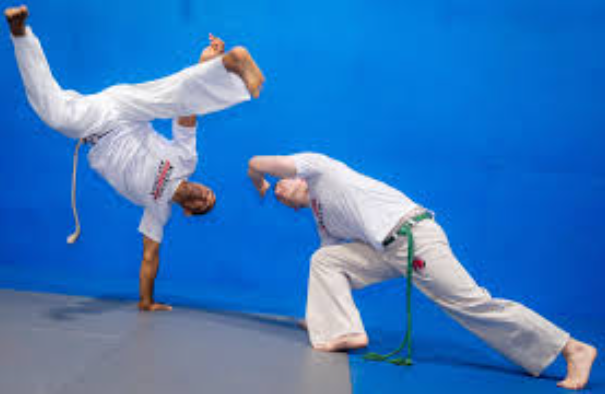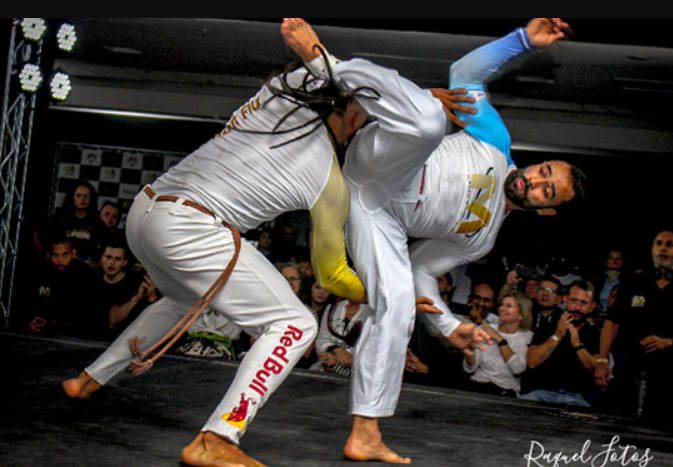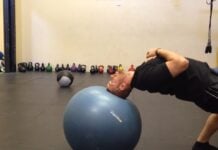
Are you looking for some new ways to spice up your BJJ game? Do you want to learn some moves that will challenge your mobility, flexibility, coordination, balance, creativity, and fitness? If so, you might want to check out capoeira, a martial art and a culture that originated in Brazil.
Capoeira is a unique blend of fighting, dancing, music, and acrobatics. It was developed by African slaves in Brazil as a way of resisting oppression. Capoeira is played in a circle called a roda, where two capoeiristas (practitioners of capoeira) exchange movements of attack and defense in a rhythmic dialogue.
Capoeira can offer many benefits for BJJ practitioners, as it can improve your physical and mental skills. It can help you develop your rhythm, timing, footwork, distance management, and unpredictability. It can also teach you awareness, agility, reflexes, and counterattacks. Moreover, capoeira can inspire you to be more creative and expressive in your grappling game.
In this article, we will introduce some basic capoeira moves that can be adapted and applied to BJJ situations. These moves are ginga, esquiva, rasteira, vingativa, and au. We will explain what they are, why they are important, how they can be used in Jiu-Jitsu, and how to practice them. By the end of this article, you will have some new tools to add some Brazilian flair to your grappling game.
What is Capoeira?
Before we dive into the capoeira moves for BJJ, let’s first understand what capoeira is and where it comes from.
Capoeira is a Brazilian art form that combines martial arts, dance, acrobatics, music and spirituality. It developed in the 16th century by enslaved Africans from various cultures, mainly from West and Central Africa. It was a way of expressing their identity and resistance in the face of oppression.
Capoeira is performed in the capoeira circle called a roda, where two capoeiristas (practitioners of capoeira) exchange movements of attack and defense in a rhythmic dialogue. The movements are accompanied by music played by a small ensemble of instruments, such as the berimbau (a musical bow), the atabaque (a drum), the pandeiro (a tambourine), and the agogô (a bell). The music also includes call-and-response songs that convey the history, philosophy, and ethics of capoeira.
Capoeira is not only a physical activity, but also a cultural and spiritual one. It teaches values such as respect, solidarity, harmony, and freedom. It also fosters a sense of community and belonging among its practitioners and capoeira mestres.
Capoeira has evolved over time and has different styles and schools. Some of the most popular ones are:
- Capoeira Angola: the oldest and most traditional style of capoeira, characterized by slow and low movements, close contact, and emphasis on strategy and malicia (deception).
- Capoeira Regional: a more modern and dynamic style of capoeira, characterized by fast and high movements, acrobatics, and emphasis on technique and speed.
- Capoeira Contemporânea: a hybrid style of capoeira that incorporates elements from both Angola and Regional styles, as well as other martial arts and influences.
Capoeira is a beautiful and unique art form that can enrich your life in many ways. It can improve your physical and mental health, your social skills, your creativity, and your self-esteem. It can also introduce you to a rich and diverse culture that has a lot to offer to the world.
The Relationship Between BJJ and Capoeira
BJJ and capoeira are both Brazilian martial arts that share some common roots and influences. Both of them were developed in Brazil with a focus of allowing a physically smaller person to fight off bigger and more prepared attackers. Both of them also incorporate elements of other martial arts, such as judo, wrestling, boxing, and karate.
However, BJJ and capoeira also have many differences in their philosophy, style, and purpose.
Brazilian Jiu-Jitsu is a sport that focuses on ground fighting and self-defense. BJJ aims to subdue the opponent by using leverage, technique, and strategy. It is based on realism, efficiency, and competition.
Capoeira is a martial art that combines fighting, dancing, music, and acrobatics. Capoeira aims to express oneself through movement and creativity. Capoeira is based on rhythm, fluidity, and playfulness.
Despite their differences, BJJ and capoeira can also complement each other in many ways. BJJ can benefit from capoeira’s mobility, flexibility, coordination, balance, creativity, and fitness. Capoeira can benefit from BJJ’s awareness, agility, reflexes, counterattacks, and submissions.
Many practitioners of BJJ and capoeira have cross-trained in both arts and have found them to be mutually enriching. Some examples of famous BJJ and capoeira practitioners are:
- Rubens “Cobrinha” Charles: a multiple-time world champion in BJJ who also practices capoeira
- Guilherme Santos: a black belt in BJJ who also teaches capoeira for BJJ
- John Machado: a coral belt in BJJ who also incorporates capoeira into his teaching
- Marcio Santos: a black belt in BJJ who also trains capoeira with John Machado
- Anderson Silva: a former UFC champion who has a black belt in BJJ and also practices capoeira
Useful Capoeira Moves for BJJ
If you are a BJJ practitioner who wants to spice up your grappling game with some new and exciting moves, you might want to learn some capoeira moves. Capoeira can offer many benefits for BJJ practitioners, such as mobility, flexibility, coordination, balance, creativity, and overall physical fitness.
Ginga: The Fundamental Movement of Capoeira
The first and one of the most fundamental Capoeira movements that is usually practiced by the beginner capoeirista is the ginga. Ginga means swing or sway in Portuguese. It is a moving base that allows the practitioners to strike and evade.
Ginga is performed by stepping back with one leg and raising the forearm on the same side to protect your face. Lean forward slightly. This is the base position.
From the base position, step laterally with the back leg. Here, you should be squatting slightly with your feet slightly more than shoulder width apart.
This is the parallel position. If you step back with the opposite leg and switch your arms, you’ll be in the base position on the opposite side.
At its most basic, the ginga is the movement between these two positions.
Ginga is important because it develops rhythm, timing, footwork, distance management, and unpredictability. Ginga helps you to adapt to your opponent’s movements and create openings for attacks or defensive movements. Ginga also helps you to express yourself and communicate with your opponent through your body language.
Ginga can be used in BJJ to set up takedowns, sweeps, transitions, and escapes. For example, you can use ginga to feint a kick or a punch and then shoot for a double leg takedown. You can also use ginga to switch sides or to evade your opponent’s attacks.
To practice ginga, start slowly and smoothly. Keep your arms up and your knees bent. Vary your speed and direction. Try to sync your movements with music or with your partner’s other movements.
Esquiva: The Art of Dodging
Esquiva means dodge in Portuguese. It is a dodge that avoids an attack by moving the body away from the line of force.
Esquiva is performed by squatting down and leaning your chest into your knee. Cover your face with your hand and forearm. Keep your elbow parallel to the ground. This is the esquiva lateral (side dodge).
You can also perform esquiva baixa (low dodge) by taking a small step back with your back leg from the base position and squatting down with your weight on the front leg.
Optionally, place the hand not covering you face onto the floor. Another option is esquiva atras (back dodge) by twisting 90 degrees towards your raised hand from the base position and squatting as if into a chair. Extend the arm to parry any incoming attacks and gauge distance.
Esquiva is important for both capoeira and BJJ because it teaches awareness, agility, reflexes , and counterattacks. Esquiva helps you to avoid getting caught by your opponent’s attacks. Esquiva also helps you to create opportunities to counter attack while in motion or escape.
To practice esquiva, practice different types of esquivas (lateral, baixa, atras). Use your hands to cover your face and parry incoming attacks. Use your eyes to follow your opponent’s movements. Try to anticipate and react quickly to your opponent’s attacks.
Rasteira: A Sneaky Leg Sweep
Rasteira means sweep in Portuguese. It is a leg sweep that trips the opponent by hooking their ankle or calf with your foot.
Rasteira is performed by lowering your upper body and extending your arm for balance and protection. Swing your leg with momentum and control. Aim for your opponent’s ankle or calf with your instep or heel.
It is a quick and effective way to take down your opponent or disrupt their balance. Rasteira can surprise your opponent with its angle and trajectory. Rasteira can also set up other attacks or transitions.
Rasteira can be used in BJJ to sweep your opponent from standing, half kneeling or kneeling positions.
For example, you can use rasteira to hook your opponent’s front leg when they are in a ginga position and then take them down. You can also use rasteira to hook your opponent’s leg when they are in your guard and then sweep them over.
To practice rasteira, use your hips and core to generate power and leverage. Keep your balance and posture throughout the sweep. Snap your leg back after the sweep.
Vingativa: A Cunning Reversal
Vingativa means revenge in Portuguese. It is a reversal that involves grabbing the opponent’s leg or arm and twisting their body to the opposite direction.
Vingativa is performed by using your legs and arms to secure the opponent’s limb and control their movement. Use your hips and shoulders to rotate your body and create momentum. Use your weight and leverage to flip your opponent over.
Vingativa is a clever way to escape from a bad position or a submission attempt. It can catch your opponent off guard with its speed and force. This motion can also lead to a dominant position with lots of body control.
Vingativa can be used in BJJ to escape from side control or mount position. For example, you can use vingativa to grab your opponent’s arm when they are in side control and then twist them over to reverse the position.
You can also use vingativa to grab your opponent’s leg when they are in mount and then roll them over to get on top.
To practice vingativa, use your legs and arms to secure the opponent’s limb and control their movement. Use your hips and shoulders to rotate your body and create momentum. Use your weight and leverage to flip your opponent over.
Au: A Dynamic Cartwheel
Au means cartwheel in Portuguese. It is a cartwheel that involves placing one or both hands on the ground and rotating the body sideways.
Au is performed by placing one hand on the ground and lifting one leg over it. Then place the other hand on the ground and lift the other leg over it. Return to the starting position or continue the movement in the same direction.
Au is a fundamental movement that improves mobility, flexibility, coordination, balance, and strength. Au helps you move around the roda or the mat with ease and grace. Itu also helps you express yourself and have fun.
Au can be used in grappling to transition from one side of the body, to attack your opponent with a submission or a sweep while in motion, or confuse or deceive your opponent with a feint or a fake.
To practice au, start with a basic au and progress to more advanced variations. Keep your legs straight and your toes pointed. Use your core and your arms to support your body weight. Look at your target before and after the au.
Conclusion
In this article, we have introduced some basic capoeira moves that can be adapted and applied to BJJ situations. These moves are ginga, esquiva, rasteira, vingativa, and au. We have explained what they are, why they are important, how they can be used in BJJ, and how to practice them.
Capoeira is a martial art and a culture that can benefit BJJ practitioners in many ways. Playing capoeira can improve your physical and mental skills, such as mobility, flexibility, coordination, balance, creativity, and endurance.














































